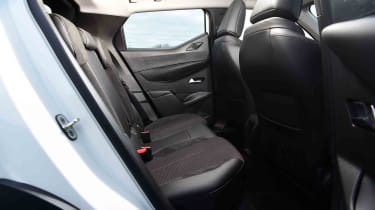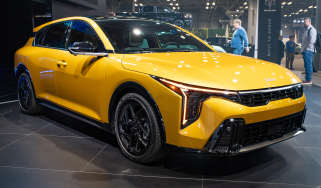DS 3 - Practicality, comfort and boot space
The DS 3’s focus on style means practicality is compromised versus rivals

The DS 3 is a small five-door SUV, but it doesn’t offer much more in the way of practicality over larger superminis – there’s seating for five and an average-sized boot, but you’ll find more overall space inside a Volkswagen Polo.
We’re not fans of the driving position either. Hard seats and a limited range of adjustment to the driver’s seat and steering wheel mean you may find it hard to get comfortable behind the wheel. All-round visibility isn’t fantastic, but we found the car easy to place on the road. Its pronounced bonnet edges help make judging the car’s size around town easy.
Elsewhere, the DS 3’s odd ergonomics continue with cupholders located behind the gear selector, a wireless phone charger pad (where fitted) that might not fit larger phones, and small door bins. It may look interesting, but user-friendliness wasn’t a major priority when this small SUV was designed.
Size
The DS 3 measures 4,118mm in length, 1,988mm wide (including mirrors) and 1,534mm tall. For comparison, the Audi Q2 is a little longer at 4,191mm and wider at 2,009mm (with mirrors), but is lower at 1,508mm. The decent ground clearance of 170mm is worth noting, and could be helpful on farm tracks or large speed bumps.
Leg room, head room & passenger space
Space for the driver and passenger in the front of the DS 3 is decent and it should prove comfortable sitting here, provided you can adjust the seats to suit. It’s a different story in the rear, where space for passengers’ legs and heads is limited and certainly below average for the class. If you plan on regularly carrying adults in the back, rivals like the Renault Captur and Volkswagen T-Cross are a better bet due to having a sliding rear bench with the opportunity to increase rear leg room. There’s enough space for children and smaller teenagers, though.
It’s quite dark and dingy in the rear too, thanks in part to tinted rear glass and a small glasshouse that’s interrupted by a protruding design feature on the high window line, so children may struggle to see out. ISOFIX points are supplied on the outer two rear seats.
Boot
There’s an adequate amount of space in the back, with 350 litres on offer in both the petrol and electric DS 3, plus 1,050 litres of cargo space with the 60/40 split rear seats folded down. But by contrast, the MINI Countryman boasts a 450-litre boot that can expand to 1,390 litres.
Small issues include a high boot lip with a drop down to what is a rather deep boot floor, along with a rear bench that doesn’t quite fold flat – there’s a step between the boot and the folded seats that might hamper loading.
Towing
All petrol DS 3 models are rated to tow a braked trailer of up to 1,200kg or an unbraked trailer weighing up to 640kg. The maximum tow hitch download is 48kg. Anyone looking for more serious pulling power in a car of this size must go for the four-wheel drive ‘4Motion’ VW T-Roc, which can tow up to 1,700kg in both 2.0-litre petrol and diesel forms.
The electric E-Tense isn’t rated to tow anything, so if you need an EV that can tow, take a look at the Volvo EX30.










